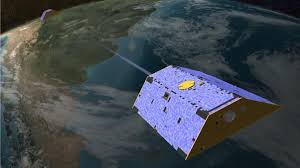In an unprecedented scientific revelation, NASA GRACE (Gravity Recovery and Climate Experiment) satellites have exposed the deep-Earth processes responsible for a long-standing gravity anomaly, reshaping scientists’ understanding of the planet’s internal structure and mass movement. The findings published this week by NASA researchers in collaboration with the Jet Propulsion Laboratory (JPL) and several international universities shed light on how mantle convection and density variations beneath the Earth’s crust create subtle but measurable variations in gravity.
This discovery not only increases our knowledge of the planet’s internal dynamics but also provides important clues about how Earth’s mass distribution affects climate, ocean currents, and tectonic activity on geological time scales.
A breakthrough in understanding Earth’s gravitational field
Since launching in 2002, NASA’s GRACE mission – and its successor, GRACE-FO (Follow-On) – have been instrumental in tracking changes in Earth’s gravity field. By measuring the distance between two twin satellites orbiting the planet, GRACE can also detect subtle changes in the gravitational pull caused by the redistribution of mass on and below the Earth’s surface.
The latest data analysis has revealed an unusual gravity anomaly centered deep beneath the Indian Ocean and extending to parts of the Southern Hemisphere. Scientists describe this anomaly as a localized weakening of gravity, indicating the presence of less-dense material within the Earth’s mantle – possibly the remains of ancient tectonic plates or large-scale convection currents.
“This is one of the clearest pieces of evidence yet that deep mantle processes, occurring hundreds of kilometers below the surface, can create measurable gravitational effects,” said Dr. Michael Watkins, project scientist at NASA’s JPL.
What Is a Gravity Anomaly?
A gravitational anomaly occurs when an area of the Earth’s surface exhibits more or less gravitational attraction than expected. Such anomalies may result from factors such as underground rock density, tectonic shifts, or the movement of fluids within the Earth’s crust and mantle.
While many known anomalies are linked to surface or near-surface phenomena – such as mountain ranges or oceanic trenches – the newly identified anomaly found by GRACE arises from deep-seated mantle dynamics, offering a rare glimpse into the planet’s hidden geological machinery.
NASA scientists used advanced models combining GRACE data, seismic readings and mantle flow simulations to determine the origin of the anomaly. Their findings show that slow, swirling streams of molten rock in the lower mantle are redistributing mass over millions of years, causing subtle changes in the planet’s gravitational field.
Indian Ocean: the center of mystery
The area in focus lies beneath the Indian Ocean Geoid Low (IOGL) – a region where Earth’s gravitational pull is weaker than average. This anomaly has puzzled geophysicists for decades. Using GRACE and seismic data, scientists have now found that the IOGL is likely caused by a dense mantle plume sinking deeper toward the Earth’s core and interacting with older tectonic material.
These complex mantle movements produce buoyancy variations, which, in turn, affect the planet’s gravitational signature.
“Our findings confirm that low gravity in the Indian Ocean is not simply a surface or crustal feature – it is a dynamic fingerprint of deep-Earth convection,” said Dr. Ananya Rao, a geophysicist at the Indian Institute of Science and co-author of the study.
Global Implications of the Discovery
Beyond explaining one of Earth’s most enigmatic geophysical features, this discovery has far-reaching implications for understanding plate tectonics, climate systems, and sea-level changes. Gravity anomalies influence how mass — such as water, ice, and even atmospheric gases — redistributes across the planet.
The GRACE satellites have already been crucial in tracking melting ice sheets, groundwater depletion, and sea-level rise. Now, their ability to detect deep-Earth changes opens new avenues for studying long-term planetary evolution and mantle-core interactions.
NASA’s analysis also suggests that similar deep-seated anomalies may exist beneath other regions, such as the Pacific Ocean and parts of Africa, potentially linked to ancient supercontinent cycles.
Advanced Technology Behind the Discovery
The GRACE and GRACE-FO missions use a precise microwave-ranging system to measure the distance between the two satellites — about 220 kilometers apart — with accuracy better than a micrometer. When one satellite passes over a region with slightly higher gravity, it accelerates, altering the distance between the pair. These subtle changes are then used to construct high-resolution maps of Earth’s gravitational field.
Recent improvements in data processing, aided by artificial intelligence and high-performance computing, have allowed researchers to filter out noise and isolate long-term gravity trends linked to mantle convection and density variations deep within the planet.
Scientific Reactions and Future Research
This discovery has attracted widespread attention from the global scientific community. Geophysicists see this as an important leap forward in understanding how Earth’s deep interior connects to surface events.
“This is a milestone moment. It is the first time that satellite gravimetry has revealed evidence of mantle convection directly affecting surface gravity,” said Dr. Eva Bloxham, a geodynamicist at Harvard University.
NASA plans to continue using GRACE-FO data in conjunction with upcoming missions such as SWOT (Surface Water and Ocean Topography) and NISAR (NASA-ISRO Synthetic Aperture Radar) to refine Earth’s dynamic models further. The integration of satellite gravimetry, radar imaging, and seismic monitoring can provide a comprehensive view of how deep-Earth processes influence surface geology and environmental systems.
conclusion:
The discovery of the NASA Grace satellite marks a transformative step in Earth science, revealing that the planet’s gravitational variations are deeply linked to processes occurring beneath the crust. These insights help scientists not only more accurately characterize the planet’s composition, but also understand how Earth’s interior evolves and shapes the world we live in.
By linking deep mantle dynamics with gravitational field fluctuations, NASA’s GRACE mission confirms the power of space-based observations in uncovering secrets hidden deep within our planet. As researchers continue to explore these hidden processes, one thing has become clear – the Earth is more dynamic and interconnected than ever before.












